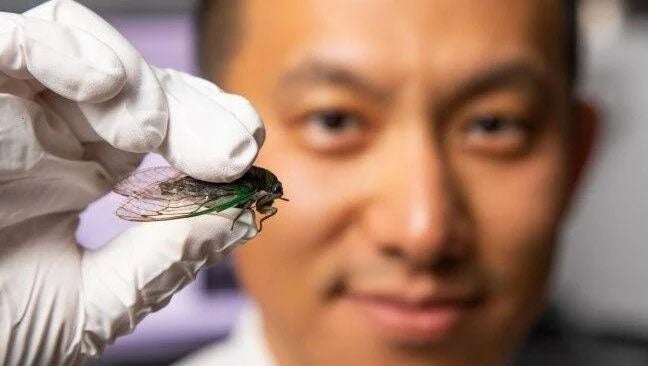UofL researchers find use for cicada wings
Published 11:44 am Wednesday, September 27, 2023

- Chuang Qu, a senior research engineer at U of L’s J.B. Speed School of Engineering specializing in advanced nanofabrication, holds a cicada. Cicada wings’ antibacterial properties in particular interested University of Louisville engineers. U of L photo
|
Getting your Trinity Audio player ready...
|
By Tom Latek
Kentucky Today
Researchers at the University of Louisville have developed a fabrication technique to efficiently and accurately imitate the nanostructure of cicada wings for potential use as an antimicrobial.
Discoveries in nature often inspire scientists to create things that benefit people. For example, the wings of the North American annual cicada – whose distinctive sound heralds the end of summer – are inhospitable to bacteria, antireflective, hydrophobic and provide camouflage.
“We often look to mother nature for interesting things, said Kevin Walsh, associate dean of research and facilities, a professor of electrical engineering at U of L’s J.B. Speed School of Engineering, and founding director of U of L’s Micro/Nano Technology Center. “When scientists take a look at these things, it often involves the nanoworld.”
Cicada wings’ antibacterial properties in particular interested University of Louisville engineers. Along with UofL biologists, the team analyzed the nanostructure of the insects’ wings and developed a nanofabrication technique to replicate it for potential use in spaces where bacteria are undesirable, such as food service, health care facilities and medical devices.
The team, led by Chuang Qu, Walsh and Mark Running, has developed a process to synthesize a surface material that mimics the wings’ structure and has the same antibacterial and water repellant properties as the wings that inspired it. The development and testing of the innovative manufacturing process was made possible using facilities at MNTC, which include a scanning electron microscope and nanomaterial production capabilities.
With the help of an SEM, scientists can see that cicada wings’ surface consists of tiny, bowling-pin-shaped structures with a diameter of around 100 nanometers – about one-thousandth of the diameter of a human hair. The wings owe their antibacterial properties to the spike-shaped tops which act like daggers, piercing the cellular membranes of bacteria that have the misfortune of landing on them, ultimately killing the bacteria.
Since the cicada wings and the replica material rely on physical nanostructures to kill the bacteria and can be made of virtually any material, the surfaces avoid possible negative effects of chemical antimicrobials in biomedical applications.
While further work is needed to fully adapt the material to commercial use, researchers believe it has potential for applications such as on doorknobs or other surfaces that need to be kept clean and germ free, food preparation surfaces and implantable medical devices that are prone to bacterial infection.




